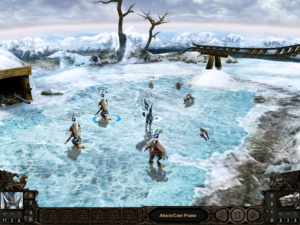Etherlords: Switching Sides
So, here I am again, making repeated posts about my failure to make progress in a turn-based fantasy strategy game. I’ve started the other campaign in the hope that this will help. There are four four sides in the conflict, but in campaign mode, they’ve divided into two alliances, so you have the red/black campagin and the green/blue campaign. I had started out on the green/blue (or Vitals/Kinets, as the game calls them), which gives you just green heroes on the first two maps and switches to blue on map 3. The red/black (Chaots/Synthets) campaign similarly starts you out red, and switches to black on the third map. How it goes after that, I still don’t know.
It’s not at all unusual for strategy games to provide two or more separate campaigns, so you can play as both the good guys and the bad guys — although, as I’ve pointed out, there aren’t really any good guys in Etherlords. How the different outcomes are reconciled varies from game to game: some, like Command & Conquer, treat them as alternate and exclusive events resulting in the complete victory of whichever side you played, while others, like Starcraft, treat them as happening one after the other. The original Warcraft was notable for providing two campaigns that seem like they both end the war in victory, and thus are incompatible, but if you were paying close attention, you realized that they could in fact be taking place simultaneously — and indeed, the sequel is predicated on the consequences of the final missions of both sides.
In a game with asymmetric sides, providing multiple campaigns is also a way to give the solo player the full experience, letting them use everything and have everything used against them. And the sides in Etherlords do play rather differently in combat mode: blue has cheap flying units, red has lots of direct-damage spells, and so forth. (I’ll have to do a fuller post on the differences, once I have a better handle on black.) But combat mode isn’t really where I’m having problems. It’s in the strategic map that I can’t seem to get things organized fast enough, and that’s basically the same for both sides, apart from the graphics. Still, playing as black, and seeing what tactics I fall to as black, might give me some ideas about tactics to use against black. Better tactics could mean that I could challenge the high-level heroes earlier.
 Comments(0)
Comments(0)